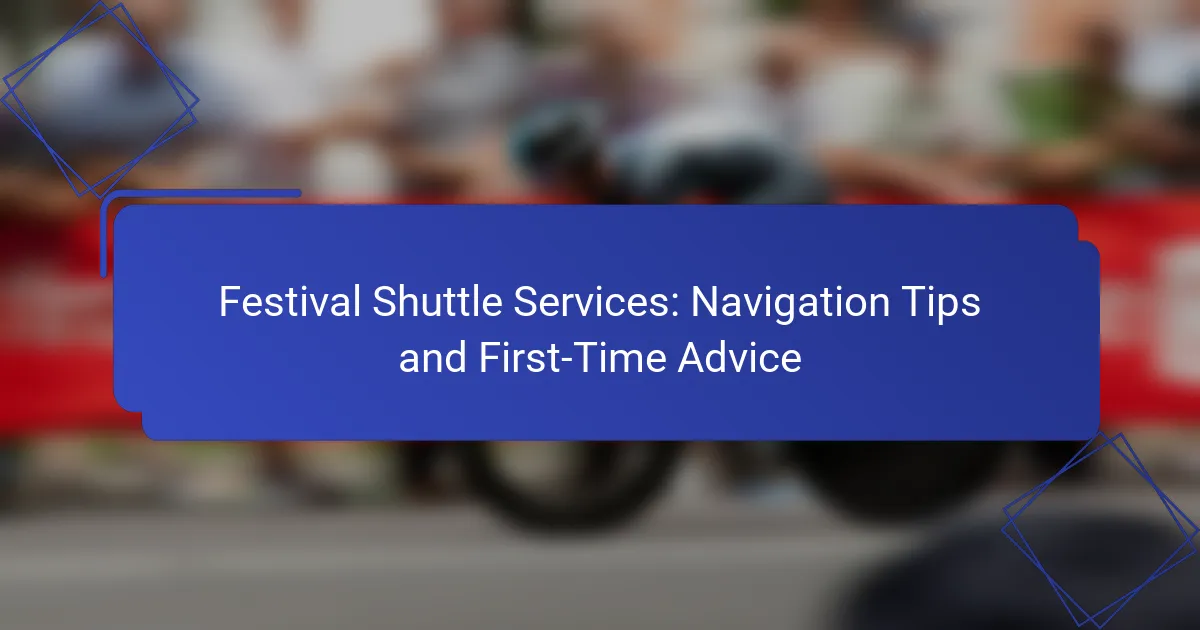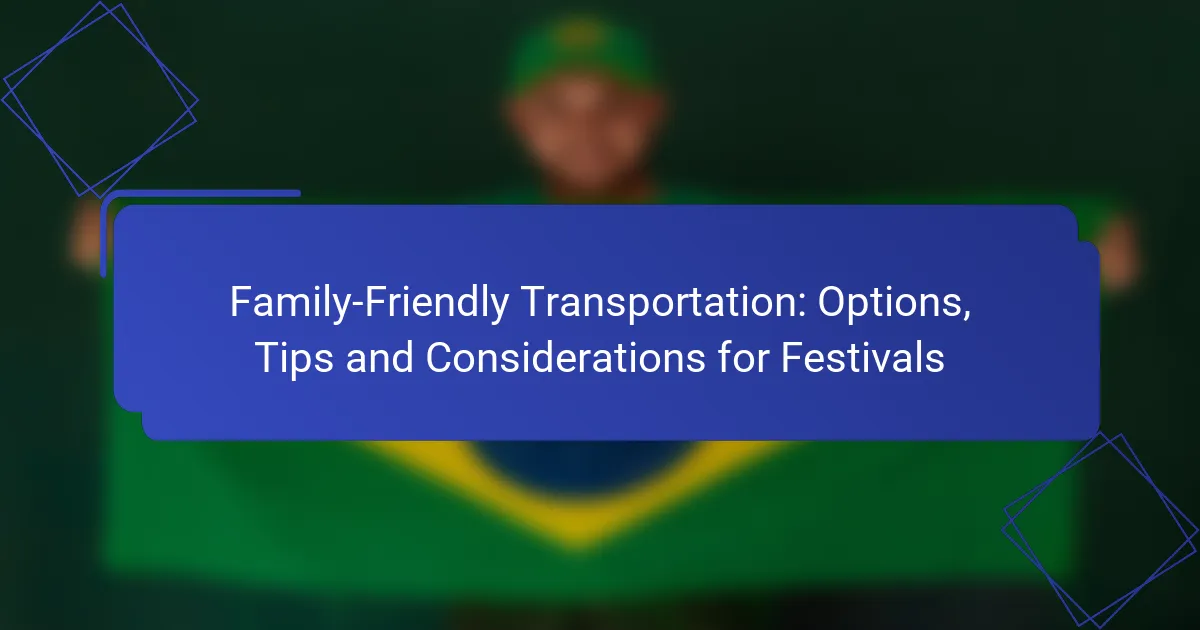Ensuring accessibility in festival transportation is crucial for creating an inclusive experience for all attendees. This involves providing various options such as shuttle services, public transport adaptations, and on-site assistance, while also adhering to regulations that promote equal access for individuals with disabilities. By leveraging resources from nonprofit organizations and advocacy groups, festivals can enhance mobility and ensure compliance with accessibility standards.
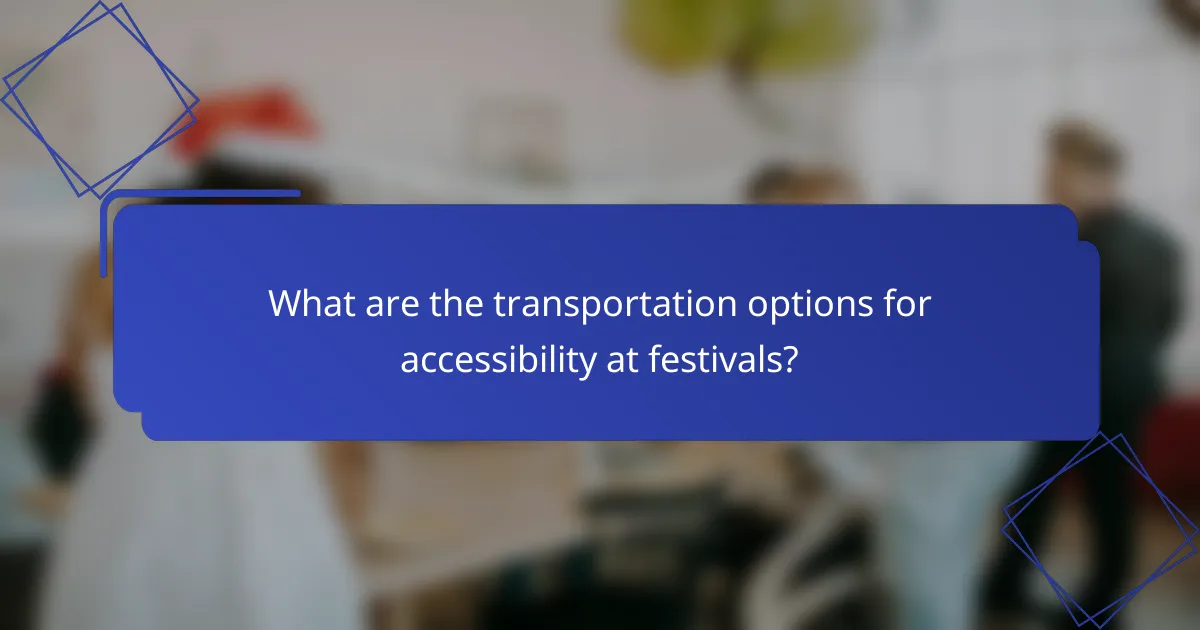
What are the transportation options for accessibility at festivals?
Accessible transportation options at festivals include shuttle services, public transport adaptations, on-site assistance, parking accommodations, and ride-sharing services with accessibility features. These options ensure that all attendees can navigate the festival grounds comfortably and safely.
Accessible shuttle services
Many festivals offer dedicated shuttle services designed for individuals with mobility challenges. These shuttles typically feature low floors, ramps, and designated seating to accommodate wheelchairs and other mobility devices.
When planning your visit, check the festival’s website for shuttle schedules and routes. It’s advisable to arrive early, as these services can become crowded, especially during peak times.
Public transportation adaptations
Public transportation systems often make adjustments during festivals to enhance accessibility. This may include extended service hours, additional accessible vehicles, and designated stops near festival entrances.
Review local transit authority announcements for specific adaptations, and consider using transit apps that provide real-time updates on accessible routes and services.
On-site mobility assistance
Many festivals provide on-site mobility assistance, such as wheelchairs or scooters available for rent. This service allows attendees to navigate the festival grounds without fatigue or difficulty.
It’s recommended to reserve mobility aids in advance if possible, as availability can be limited during busy events. Check with the festival organizers for specific rental procedures and costs.
Parking accommodations
Accessible parking is typically available at festival venues, often located close to entrances. These spaces are reserved for individuals with valid disability permits or licenses.
To avoid complications, arrive early to secure a spot and ensure you have the necessary documentation displayed in your vehicle. Familiarize yourself with the parking layout in advance for a smoother experience.
Ride-sharing services with accessibility features
Ride-sharing services like Uber and Lyft offer vehicles equipped for accessibility, including vans with ramps and spacious interiors. These services can be a convenient option for getting to and from festivals.
Before booking, confirm that the ride-sharing app allows you to request an accessible vehicle. It’s wise to check estimated arrival times and availability, especially during high-demand periods like festivals.
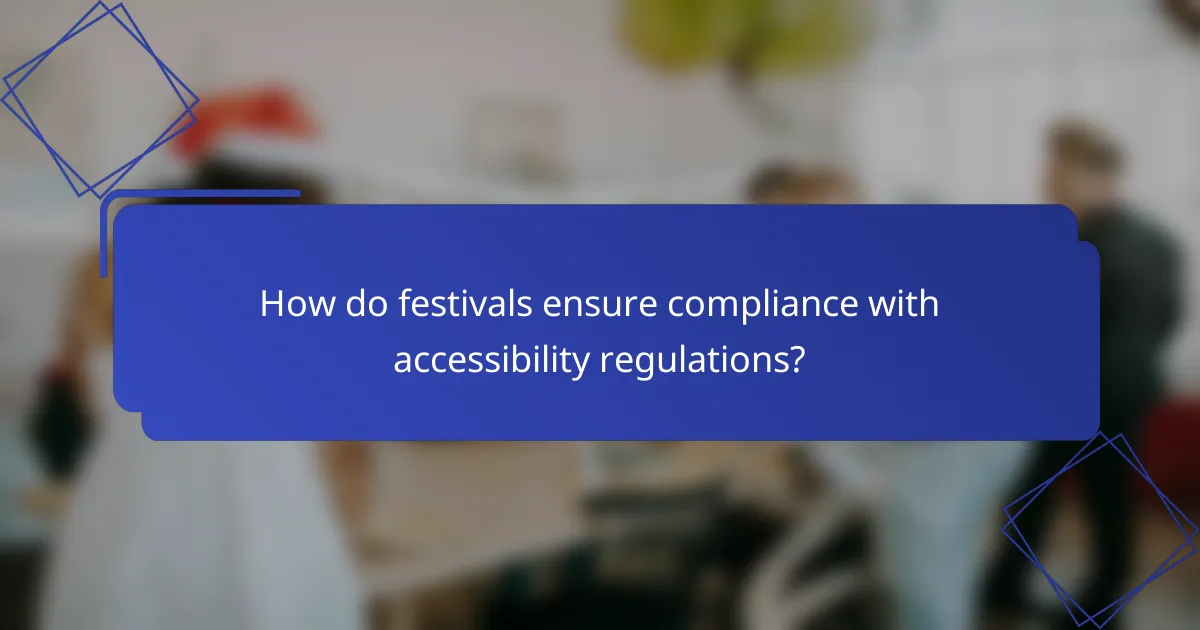
How do festivals ensure compliance with accessibility regulations?
Festivals ensure compliance with accessibility regulations by adhering to established guidelines and local laws that promote equal access for individuals with disabilities. This involves implementing necessary accommodations in transportation, facilities, and services to create an inclusive environment for all attendees.
ADA compliance guidelines
The Americans with Disabilities Act (ADA) outlines specific requirements for public events, including festivals. Key guidelines include providing accessible parking, pathways, and restrooms, as well as ensuring that all transportation options are equipped to accommodate individuals with mobility challenges.
For example, festival organizers should ensure that shuttle buses are wheelchair accessible and that there are designated drop-off zones close to event entrances. Regular training for staff on ADA compliance can also enhance the overall experience for attendees with disabilities.
Local regulations and standards
In addition to ADA guidelines, local regulations may impose additional accessibility requirements that vary by region. These can include specific building codes, public transportation standards, and emergency evacuation procedures tailored for individuals with disabilities.
Festivals should consult local authorities to understand these regulations and ensure compliance. Engaging with local disability advocacy groups can also provide valuable insights into best practices and community expectations for accessibility.
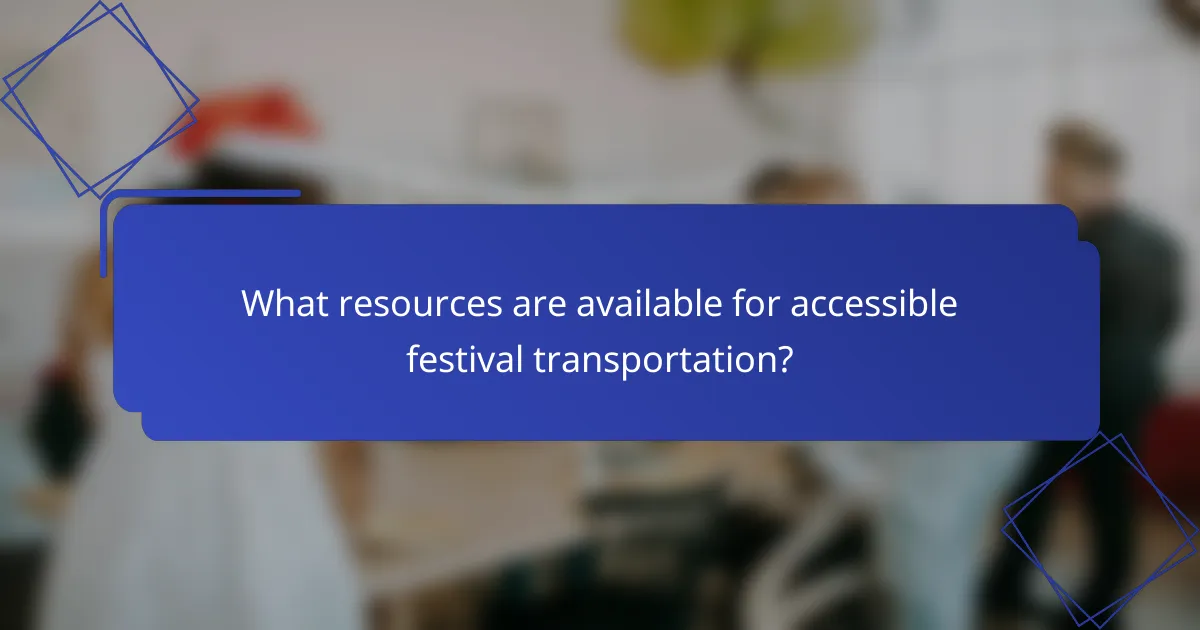
What resources are available for accessible festival transportation?
Accessible festival transportation resources include nonprofit organizations, government grants, and advocacy groups that focus on improving mobility for individuals with disabilities. These resources provide essential support, information, and funding to ensure that transportation options are inclusive and compliant with accessibility standards.
Nonprofit organizations for accessibility
Nonprofit organizations play a crucial role in enhancing accessible transportation options for festivals. They often provide services such as shuttle buses equipped with wheelchair lifts, volunteer drivers, and information on accessible routes. Examples include local chapters of national organizations like the American Association of People with Disabilities (AAPD) and regional groups focused on specific communities.
When seeking assistance, check if these nonprofits offer partnerships with festival organizers to ensure that transportation is adequately planned. Engaging with these organizations can also help identify additional resources and funding opportunities.
Government resources and grants
Government resources, including grants and funding programs, are available to support accessible transportation initiatives. Programs like the Federal Transit Administration’s (FTA) grants can help local governments enhance their transportation services for people with disabilities. These funds can be used for purchasing accessible vehicles or improving existing infrastructure.
To access these resources, festival organizers should familiarize themselves with local and federal grant application processes. It’s beneficial to collaborate with local transit authorities to ensure compliance with the Americans with Disabilities Act (ADA) and other relevant regulations.
Accessibility advocacy groups
Accessibility advocacy groups work to promote awareness and influence policy changes regarding transportation for individuals with disabilities. They often provide valuable insights into best practices for ensuring that festival transportation meets accessibility standards. Groups like the National Council on Independent Living (NCIL) advocate for improved services and can connect festival organizers with resources.
Engaging with these groups can help identify potential challenges and solutions in transportation planning. They may also offer workshops or training sessions for festival staff on how to assist attendees with disabilities effectively.

What are the best practices for improving accessibility in festival transportation?
Improving accessibility in festival transportation involves implementing strategies that ensure all attendees, including those with disabilities, can navigate and utilize transport options effectively. Key practices include collaborating with experts, gathering feedback, and adhering to relevant regulations.
Collaboration with accessibility experts
Engaging with accessibility experts is crucial for identifying barriers and developing effective solutions in festival transportation. These professionals can provide insights into compliance with standards such as the Americans with Disabilities Act (ADA) in the U.S. or similar regulations in other countries.
Consider forming a committee that includes accessibility advocates, transportation officials, and festival organizers. This collaboration can help create a comprehensive plan that addresses various needs, from wheelchair access to sensory-friendly transport options.
Feedback from festival attendees
Collecting feedback from festival attendees, especially those with disabilities, is essential for improving transportation services. Surveys and focus groups can reveal specific challenges faced during previous events, allowing organizers to make informed adjustments.
Implementing a feedback loop encourages continuous improvement. For instance, after each festival, solicit input on transportation accessibility and use this data to refine services, ensuring that the festival remains inclusive for all participants.
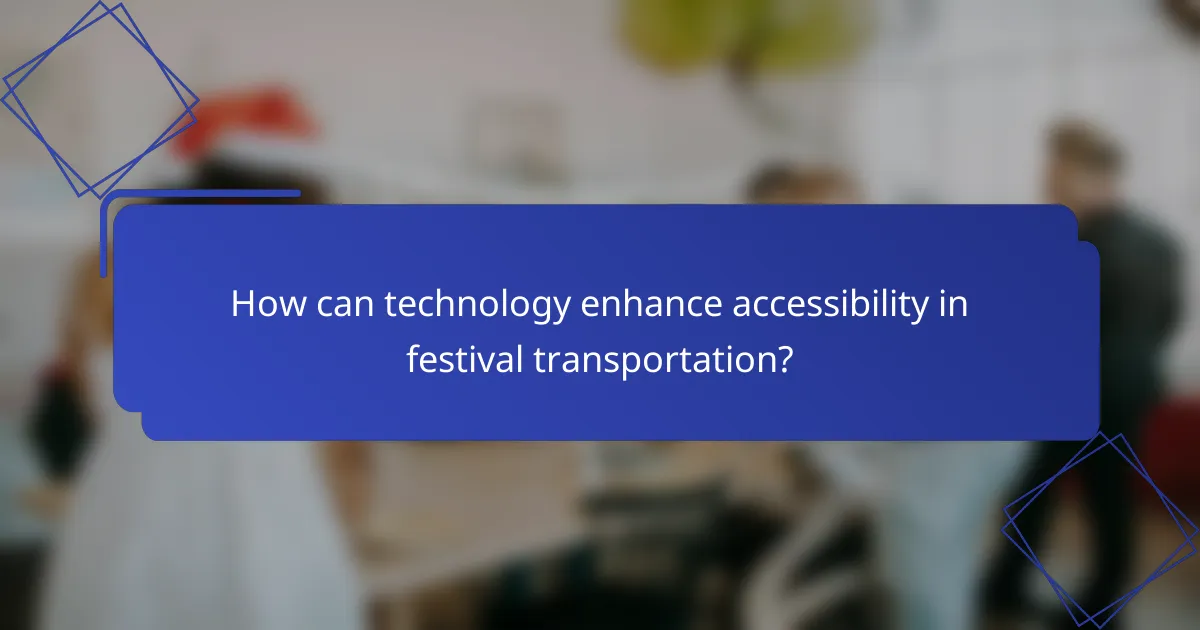
How can technology enhance accessibility in festival transportation?
Technology can significantly improve accessibility in festival transportation by providing real-time information and tracking options. This ensures that individuals with mobility challenges can navigate events more easily and efficiently, enhancing their overall experience.
Mobile apps for real-time updates
Mobile applications designed for festivals can deliver real-time updates on transportation options, schedules, and delays. These apps often feature accessibility filters, allowing users to find suitable transport services quickly.
For instance, an app might notify users of the nearest accessible shuttle or provide estimated wait times, helping attendees plan their journeys more effectively. Users should look for apps that offer user-friendly interfaces and clear accessibility information.
GPS tracking for accessible vehicles
GPS tracking technology enables users to locate accessible vehicles in real-time, ensuring they can find transportation when needed. This feature is particularly beneficial during large festivals where transport options may be limited or crowded.
By integrating GPS tracking into their services, transport providers can offer live updates on vehicle locations and estimated arrival times. Attendees should verify that the transportation services they plan to use have GPS capabilities and are equipped with accessible features, such as ramps or designated seating.
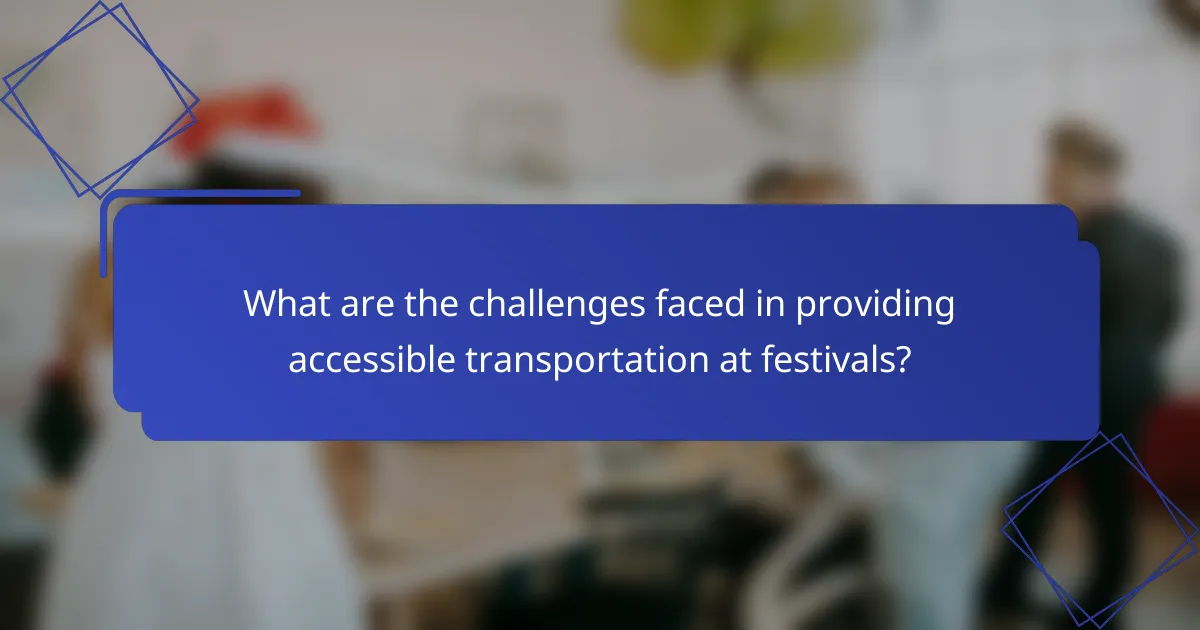
What are the challenges faced in providing accessible transportation at festivals?
Providing accessible transportation at festivals involves several challenges, including funding limitations and logistical coordination issues. These obstacles can hinder the ability to offer adequate services for individuals with disabilities, impacting their overall festival experience.
Funding limitations
Funding is often a primary challenge in ensuring accessible transportation at festivals. Many event organizers operate on tight budgets, which may not allocate sufficient resources for accessible transport options. This can lead to a lack of necessary vehicles, trained staff, and infrastructure.
To address funding limitations, organizers can explore grants, sponsorships, or partnerships with local businesses and non-profits focused on accessibility. Leveraging community resources can help enhance the available transportation options without significantly increasing costs.
Logistical coordination issues
Logistical coordination is crucial for implementing accessible transportation effectively. This includes scheduling, routing, and ensuring that vehicles are appropriately equipped for individuals with various disabilities. Poor planning can result in delays and inadequate service, frustrating users.
Organizers should prioritize clear communication with transportation providers and establish a detailed plan that includes accessible routes and timely service. Utilizing technology, such as apps for real-time tracking, can improve coordination and enhance the user experience.

